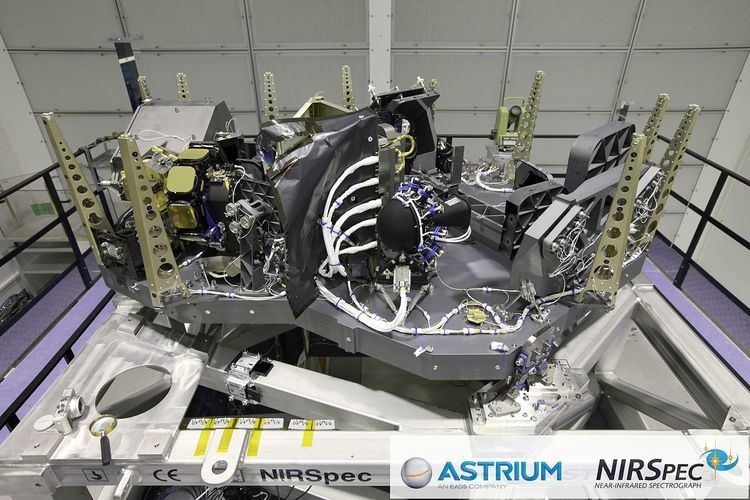Mission type Astronomy Launch mass 196 kg (432 lb) | Manufacturer Astrium | |
 | ||
Operator ESA with contributions from NASA Website ESA Europe
Astrium Germany
NASA United States Mission duration 5 years (design)
10 years (goal) | ||
The NIRSpec (Near-Infrared Spectrograph) is one of the four scientific instruments which will be flown on the James Webb Space Telescope (JWST). The JWST is the follow-on mission to the Hubble Space Telescope (HST) and is developed to receive more information about the origins of the universe by observing infrared light from the first stars and galaxies. In comparison to HST, its instruments will allow looking further back in time and will study the so-called Dark Ages during which the universe was opaque, about 150 to 800 million years after the Big Bang.
Contents
- Overview
- Science objectives
- Operational modes
- Performance parameters
- Industrial partners
- Images
- References
The NIRSpec instrument is a multi-object spectrograph and is capable of simultaneously measuring the near-infrared spectrum of up to 100 objects like stars or galaxies with low, medium and high spectral resolutions. The observations are performed in a 3 arcmin × 3 arcmin field of view over the wavelength range from 0.6 µm to 5.0 µm. It also features a set of slits and an aperture for high contrast spectroscopy of individual sources, as well as an integral-field unit (IFU) for 3D spectroscopy. The instrument is a contribution of the European Space Agency (ESA) and is built by Astrium together with a group of European subcontractors.
Overview
The JWST main science themes are:
The NIRSpec instrument operates at -235 °C and is passively cooled by cold space radiators which are mounted on the JWST Integrated Science Instrument Module (ISIM). The radiators are connected to NIRSpec using thermally conductive heat straps. The mirror mounts and the optical bench base plate all manufactured out of silicon carbide ceramic SiC100. The instrument size is approximately 1900 mm × 1400 mm × 700 mm and weighs 196 kg (432 lb) including 100 kg of silicon carbide. The operation of the instrument is performed with three electronic boxes.
NIRSpec includes 4 mechanisms which are:
Further NIRSpec includes two electro-optical assemblies which are:
And finally the Integral Field Unit (IFU) image slicer, used in the instrument IFU mode.
The optical path is represented by the following silicon carbide mirror assemblies:
Science objectives
Operational modes
In order to achieve the scientific objectives NIRSpec has four operational modes:
Multi-Object Spectroscopy (MOS)
In MOS the total instrument field of view of 3 × 3 arcminutes is covered using 4 arrays of programmable slit masks. These programmable slit masks consist of 250 000 of micro shutters where each can individually be programmed to 'open' or 'closed'. The contrast between an 'open' or 'closed' shutter is better than 1:2000. If an object like e.g. a galaxy is placed into an 'open' shutter than the spectra of the light emitted by the object can be dispersed and imaged onto the detector plane. In this mode up to 100 objects can simultaneously be observed and the spectra be measured.
Integral Field Unit Mode (IFU) The integral field spectrometry will primarily be used for large, extended objects like galaxies. In this mode an 3 × 3 arcsecond field of view is sliced into 0.1 arcsecond bands which are thereafter re-arranged into a long slit. This allows to obtain spatially resolved spectra of large scenes and can be used to measure the motion speed and direction within an extended object. Since measured spectra in the IFU mode would overlap with spectra of the MOS mode it can not be used in parallel.
High-Contrast Slit Spectroscopy (SLIT)
A set of 5 fixed slits are available in order to perform high contrast spectroscopic observations which is e.g. required for spectroscopic observations of transiting extra-solar planets. Of the five fixed slits, three are 0.2 arcseconds wide, one is 0.4 arcsecond wide and one is a square aperture of 1.6 arcseconds. The SLIT mode can be used simultaneously with the MOS or IFU modes.
Imaging Mode (IMA)
The imaging mode is used for target acquisition only. In this mode no dispersive element is placed in the optical path and any objects are directly imaged on the detector. Since the microshutter array which is sitting in an instrument intermediate focal plan is imaged in parallel, it is possible to arrange the JWST observatory such that any to be observed objects fall diretly into the center of open shutters (MOS-mode), the IFU aperture (IFU-mode) or the slits (SLIT mode).
Performance parameters
The NIRSpec key performance parameters are:
.
Industrial partners
NIRSpec has been built by Astrium Germany with subcontractors and partners spread over Europe and with the contribution of NASA from the US which provided the Detector Subsystem and the Micro-shutter Assembly.
The individual subcontracters and their corresponding contribution were:
